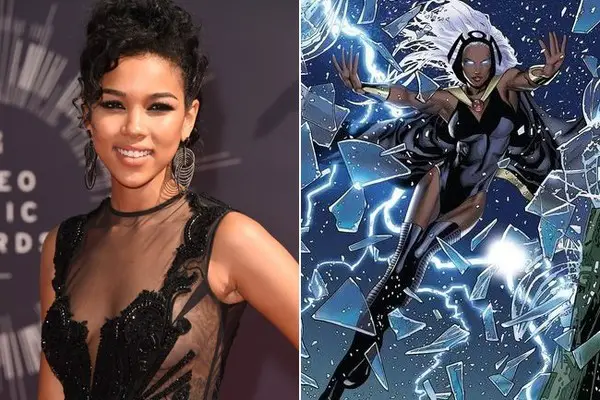About two weeks ago, the trailer for the highly anticipated film “The Hate U Give” was released. And while it does seem like a worthy movie adaptation of a standout novel, there was one aspect that I was simply not pleased with. That would be the casting of popular young adult actress Amandla Stenberg in the lead role of Starr Carter.
Stenberg is a girl of mixed-race heritage, coming from a black mother and a white father. She exhibits stereotypical “mixed girl” features, with loosely curled hair and a lighter skin tone. Her phenotype is very different from that of the girl on the book cover for “The Hate U Give” (presumably Starr herself), who has tightly coiled hair and dark skin.

I’ve been noticing a trend in mainstream Hollywood of late. Although diversity in film casting is on the rise, it would seem that there are still limitations when it comes to casting young black women in film, typically between the teenage years and early twenties.
More often than not, Hollywood tends to cast light-skinned girls when a black girl is required for a role. Now, before anyone comes after me, I do not have an issue with any of these light-skinned actresses. There’s a reason they are as successful as they are, and while their talents are obviously a factor, it would be naïve to think that their looks had no effect on their success.
Light-skinned or mixed black women being casted in mainstream films more often than dark-skinned women are is a clear indication of Hollywood’s (and really, the general media’s) colorist mentality. These women are often seen as more attractive or more acceptable because they are nearer to a Eurocentric beauty standard.
But still, these actresses aren’t exactly white, so Hollywood gets away with casting them in all black female roles, almost like throwing them in the audience’s face and saying, “Look! There’s a black girl in our movie! See, we’re diverse!” Yet, a clear look at the most popular actresses portraying young adult black women in films right now would show a not-so-diverse range of skin tones.
While it’s nice seeing more diversity in film, there are still ways to go when it comes to proper representation for young black women. One recent casting controversy that stands out is Alexandra Shipp playing the role of X-men’s Storm — a character who is dark-skinned in the comics, unlike Shipp herself.

I also noticed this same casting trend in “The Greatest Showman,” a film of which I am a fan. In the movie, a black pair of siblings are trapeze artists. While the brother is a dark-skinned man, Zendaya (a light-skinned actress) plays his sister. People who look similar are typically casted to play siblings in films, so it stood out to me that Zendaya was hired for this role.
One obvious and common rebuttal to assertions of Hollywood’s colorism is that, perhaps, these actresses are casted based on their talent and the fact that they are who is most popular among young black female actresses. But ask yourself: Why is it that the most popular actresses are predominantly light-skinned? And do you really believe that there are so few talented dark-skinned actresses?
Recently, I noticed Hollywood’s colorism once again in the development of an upcoming Netflix series called “Raising Dion.” The clips used to promote the show before official casting began featured a dark-skinned woman and child. But last month, Michael B. Jordan (who is producing the show) released a picture of himself with the officially casted actress, who is light-skinned with loosely curled hair.
“Black Panther” was a step in the right direction when it comes to young, dark-skinned female portrayals, with Letitia Wright playing 16-year-old genius Shuri. However, this likely only occurred because the film took place in Africa. Stenberg herself spoke about how she chose to drop out of the running for the role of Shuri because she knew it was not her place as a mixed girl. While I appreciate the sentiment, she should have done the same for “The Hate U Give.”

To reiterate, I do not have an issue with light-skinned actresses. In fact, I am a fan of both Stenberg and Zendaya. I thought Stenberg was perfect for the lead role in “Everything, Everything,” and I look forward to seeing Zendaya in the upcoming “Spider-Man” movies. But Zendaya herself said it best: “I am Hollywood’s, I guess you could say, acceptable version of a black girl and that has to change.”
Colorism is rampant within the black community itself. It is very important that young, dark-skinned girls see themselves reflected on screen in order for them to feel beautiful and uplifted. This is not to say that a girl’s entire self-esteem should rest in the hands of Hollywood, but it is apparent that Hollywood’s influence on what is deemed attractive or not is a strong one.
Black teens come in so many different gorgeous shades, and they should be depicted as such. There are plenty of talented, young and beautiful dark-skinned actresses that deserve exposure, such as Ryan Destiny, Lovie Simone, Ajiona Alexus and Tanyell Waivers. I would have loved to have seen any of these women take on the lead in “The Hate U Give.”
Obviously, roles should not be taken away from light-skinned actresses entirely. They key is to find a balance between them and dark-skinned actresses in terms of representation. In real life, women like Stenberg, Zendaya and Shipp are not the faces of all young black girls. As such, they should not be the only faces seen on-screen.
To quote Zendaya once again: “[Black women are] vastly too beautiful and too interesting for me to just be the only representation of that.”

















